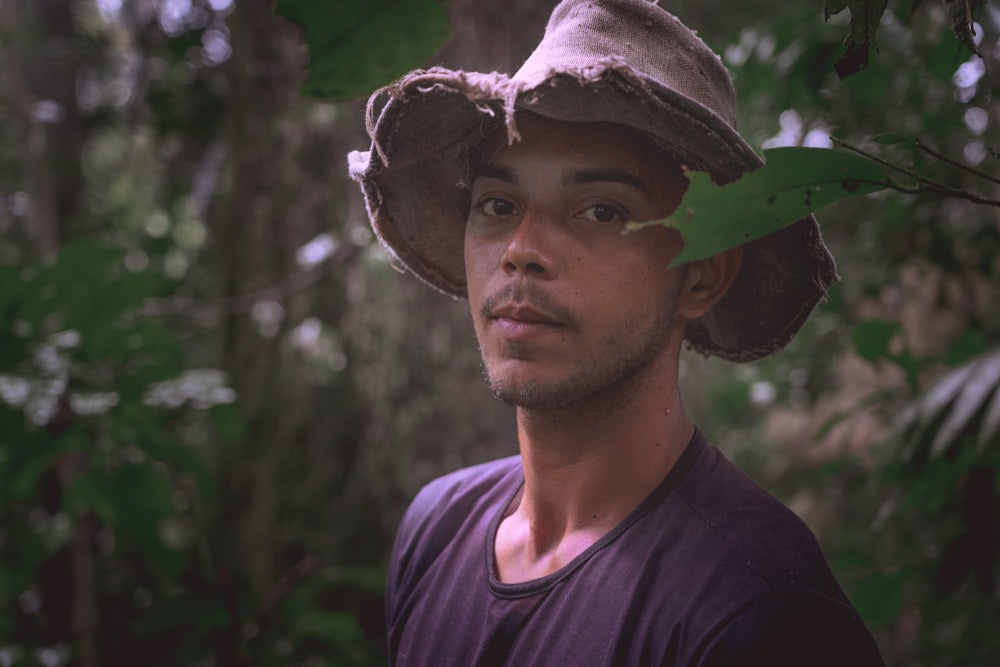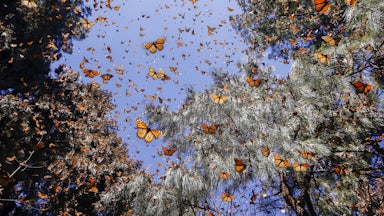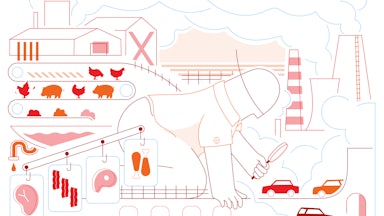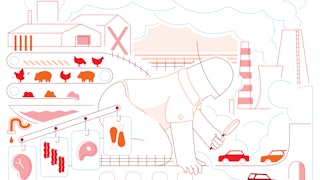On a rainy March afternoon, Rogério Mendes strides through the dripping vegetation of a tract of virgin Amazonian forest and stops at a tree with scars arranged in neat diagonal rows across its trunk. From his back pocket he produces a wood-handled tool with a blade on one end, called a cabrita, and cuts another diagonal line though the bark, beneath the others. A milky white goo—raw liquid latex—begins to trickle down this tiny canal and into a metal pail below.
“I love being in the forest, it’s an inexplicable feeling,” says the 23-year-old, who sports a tattered canvas hat and a forearm inked with tree tattoos. Rogério’s father, Raimundão, is the cousin of Chico Mendes, Brazil’s most famous environmental activist, a rubber tapper who was murdered in 1988 by a rancher who wanted to turn the family’s traditional tapping grounds into pasture. The family lives in the Chico Mendes Extractive Reserve, which was created after his death and is part of a system of more than 75 extractive reserves that have since been established across the region.
Brazil’s publicly owned extractive reserves prohibit large-scale agriculture, logging, and mining. The Indigenous groups and nonnative settlers who live there, however, may engage in more traditional and sustainable harvesting, such as rubber tapping and the collection of wild nuts, fruits, and fiber. The market for most of these products, unfortunately, is not particularly lucrative. While the reserves are considered a triumph of conservation, the lack of income-earning opportunities has led to more and more illicit clearing within their boundaries. A 2017 analysis by the Environmental Defense Fund found that 17 percent of deforestation in the Amazon occurs in protected areas, including by some of the Mendeses’ neighbors. Prior to 2013, about four square miles of forest was lost each year in the Chico Mendes Reserve, but by 2019, nearly five square miles were being lost each month.
The rivulets of sap filling Mendes’s pail will end up in the soles of high-end sneakers made by Veja, a French company that counts Meghan Markle, Reese Witherspoon, and Emily Ratajkowski among its A-list endorsers. Just like tapping maple trees for their sugary syrup, the extraction of latex does no harm to rubber trees, which grow wild only in the Amazon. It’s a forest-friendly livelihood that could potentially reduce the powerful economic incentives driving deforestation in the region—but only if it were to multiply exponentially in scale. The two million shoes Veja sells each year require enough rubber to sustain 1,200 families, but there are around 25 million people living in the Brazilian Amazon, many of them under the sway of the timber-and-cattle industrial complex, which is responsible for the vast majority of the 300,000 square miles of forest lost since 1970.
Rubber is one of dozens of products that activists hope may help save the rain forest by bolstering the Amazon’s emerging bioeconomy—a term applied to industries that encourage forests to be kept standing. Açaí, the fruit of a native palm sold as a superfood, is the most famous example and the most lucrative to date. The world’s supply of Brazil nuts originates in another wild-harvested Amazonian tree. Other more obscure fruits, seeds, oils, resins, and fibers foraged by forest-dwelling communities have found their way into consumer products, especially in the fashion and beauty industries. Aveda, L’Occitane, and Natura, the Brazilian parent company of Avon and the Body Shop, all use products from the Amazon.
This might seem like a frou-frou indulgence of brands looking to score points with earth-conscious consumers. And it is. But preserving the rain forest, experts say, will actually require trends like these in order to change the region’s political economy. Specifically, it will require a redistribution of wealth from rich countries to families like the Mendeses, who otherwise have few options to make a living that don’t involve cutting the trees. Veja pays about $2 per kilo of rubber, more than four times the current market value. It’s a wealth transfer that high-end brands are positioned to promulgate because their customers can afford to a pay a premium for exotic products.
“On top of the commercial price, we pay them for environmental services,” says Beto Bina, Veja’s head of sourcing. “It’s a beautiful supply chain that stimulates conservation and mitigates deforestation.” A study from the Federal University of Acre (commissioned by Veja) found that the income of Veja’s suppliers was 50 percent higher than that of neighboring families.
At the Mendes family home, the tension between these divergent economic paths hovers over a lunch of wild boar and homegrown rice and beans. “The younger generation is more inclined to destroy the forest—unfortunately this is the reality we live in today,” says Raimundão, who was Chico Mendes’s right-hand man, hugging trees as loggers approached with chain saws and traveling the world to draw attention to the razing of the Amazon. The Mendeses and their comrades spearheaded a Marxist-environmentalist movement that brought together Indigenous groups and rubber tappers across the Amazon in resistance to the agribusiness interests that had become entrenched in the 1980s. Raimundão, 75, shirtless with camouflage pants and a foot-long knife on his belt, has since made his peace with capitalism—the enlightened variety, anyway—recognizing that his son’s allegiance to the family tradition would be difficult without a company like Veja supporting it. “This is a very promising moment,” he says.
One trailblazer in this work is Bia Saldanha, a Brazilian fashion entrepreneur who has spent the past three decades slopping through red Amazonian mud to build forest-friendly supply chains, aided by her rare trifecta of cosmopolitan connections, entrepreneurial chops, and backwoods cred.
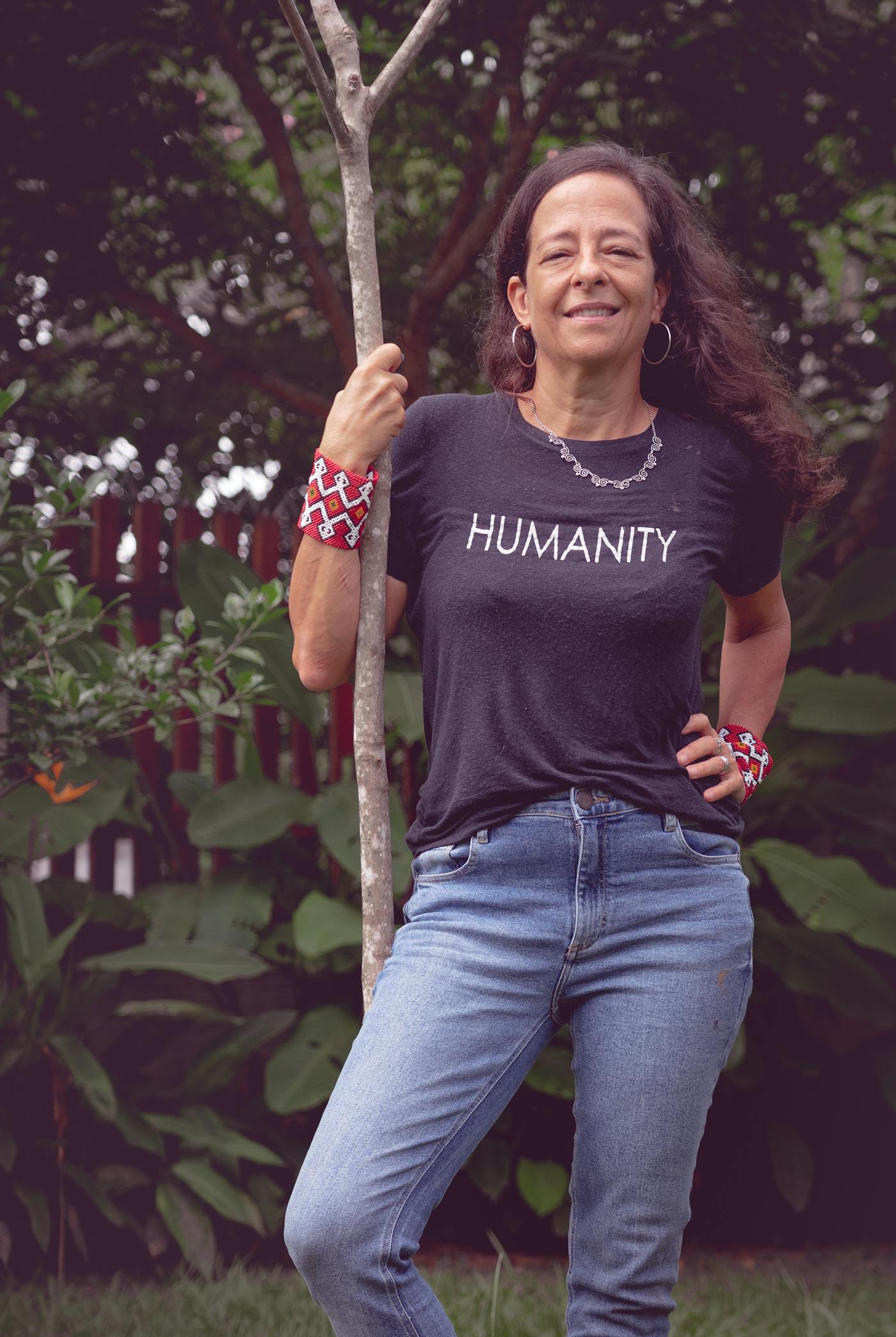
After meeting Chico Mendes in the late ’80s, she moved to the Amazon to see how she could contribute to the rubber tapper’s cause. She developed a plant-based leather by coating canvas with wild latex, a material she sold to Hermès, the French luxury brand (which made it into high-end handbags), and later managed Veja’s rubber supply chain. She’s had her hands in various other efforts to scale up the bioeconomy, including WildRubber.com, part of a World Wildlife Fund campaign to publicize the conservation benefits of Amazonian latex.
Sporting blocky, black-rimmed glasses, a black T-shirt with “HUMANITY” written across the chest, and Veja sneakers, Saldanha tells of how she helped broker a deal between Farm (a tropical-themed fashion brand with stores in Rio, Paris, and Soho) and the Yawanawa tribe to sell the tribe’s extravagant beaded wrist cuffs, which she’s also wearing.
Saldanha may sound like someone suffering from a savior-capitalist complex, but she comes by her entrepreneurialism through political activism. She holds no illusions of fashion startups overtaking the Amazon’s beef economy—if Brazil’s deforestation laws were adequately enforced, the biggest players in the cattle industry, who own ranches with tens of thousands of acres, would be held in check, she says. Her goal is to harness ethical brands in support of the small-time ranchers deeper in the forest, who are often the ones pushing open the agricultural frontier, which the larger operations then exploit. By investing in these communities, she believes it’s possible to preserve much of the forest that remains.
“We have the law, and then we have the international interests,” says Saldanha, flailing her arms in angst. “The big players—fuck them. We need solutions for the small people, because otherwise they will cut the forest. If their prosperity is not considered, there will be no forest left.”
Despite the bioeconomy’s progress, Saldanha worries it’s not growing fast enough to prevent the “tipping point”—the level of deforestation in the Amazon that scientists say will result in significant and irreversible climatic changes. She’s sharply critical of Reducing Emissions From Deforestation and Forest Degradation, or REDD, the carbon credit scheme that for the past decade has been the dominant model for first world–funded rain forest conservation, which is increasingly viewed by activists and academics as a failure. “The desperate hunger for these carbon credit plans appears to have blinded many of their advocates to the mounting pile of evidence that they haven’t—and won’t—deliver the climate benefit they promise,” noted a recent ProPublica investigation, which found that REDD projects often overstated results, lacked oversight on the ground, and fell apart in the harsh reality of impoverished forest communities.
REDD is too slow, too bureaucratic, and too disconnected from the people who actually live in the forest, says Saldanha. “They receive very little money from carbon credits—most of it goes to consultants and NGOs.”
Instead of going the REDD route, she urges companies to pay an environmental services premium directly to the suppliers on the ground—doubling the market value of the raw material is a good starting point, she suggests—and then passing the cost on to the consumer.
Brazil’s political environment adds urgency to the situation. The far-right wave that swept Jair Bolsonaro into power in 2018 upended politics in Acre, replacing the left-leaning government that had ruled the state since 1998, whose motto was “florestania,” or “forest citizenship.” As a result of the previous government’s pro-forest policies and incentives—payments for environmental services, a certification program for small family farms with sustainable practices, funding infrastructure to transform raw materials from the forest into more valuable consumer products—deforestation in Acre plunged during the first decade of the millennium, while the state’s gross domestic product grew faster than the national average. That’s no longer the case.
In 2019, massive fires across the Amazon captured the world’s attention and laid bare the unprecedented level of deforestation under Bolsonaro’s regime. The world moved on, but in 2020 the fires were even worse, leaving the state under a smoky haze for much of the dry season. “There were moments when it felt like the end of the world,” says Saldanha. Due to ongoing drought, the forecast for the 2021 fire season, which is now underway, is equally bleak. Even though Brazil has some of the toughest environmental regulations on the planet—such as a requirement for Amazonian property owners to preserve the forest on 80 percent of their land—Bolsonaro has signaled that enforcement is not a priority.
“We have a crazy president who says, Don’t worry, it’s just a fucking law,” says Saldanha, who was mortified by President Biden’s plan to give the Brazilian government $20 billion to fight deforestation. “Here in the rain forest, we are in a war with the federal government.”
Politically, the cards are stacked against the bioeconomy. The market continues to make progress, though it’s difficult to quantify as the Brazilian government only publishes data on the top half-dozen or so wild-harvested Amazonian products, which contribute about $180 million annually to the income of residents. These are generally sold on the commodity market, where prices are so low, and the cuts taken by middlemen so high, that they’re unlikely to produce much of an incentive against deforestation.
But there are signals in the data that price premiums from brands marketing forest-friendly consumer products are making a difference, suggesting a decoupling from the commodity market and a move toward artisanal supply chains, in which companies contract directly with forest communities. A new certification program has emerged to facilitate this transition on a national scale. The Origens Brasil label, established in 2016 by IMAFLORA, a nonprofit that supports sustainable development in rain forest communities, can be found on products from 29 companies that source from 35 protected areas in the Amazon.
The certification ensures that producers are paid fairly. But the deeper purpose, says Patrícia Cota Gomes, who oversees the project for IMAFLORA, is to broker business relationships between corporations and forest communities. This is distinct from labels like Rainforest Alliance and Fair Trade Certified, which play a more detached third-party certification role with producers. “We go through a whole process to sensitize and prepare companies to work with traditional populations so they can begin to relate directly,” she explains, which often involves putting CEOs on a boat to visit the community and better understand its reality. “Because you can’t just pick up the phone and ask for a delivery of these products.”
According to Gomes, the number of companies using the label grew 70 percent from 2019 to 2020, and several large international brands are in the pipeline for 2021. But the contracts brokered by IMAFLORA have produced only about $2 million in purchases from forest producers to date. Beef, on the other hand, is a $2 billion industry in the Amazon. Is it remotely realistic that the bioeconomy could ever compete? “That is the dream,” says Gomes, who points to history as a source of optimism.
In the past, wild rubber produced almost unimaginable wealth. The boom at the turn of the twentieth century was so lucrative that over a couple decades, the small Amazonian town of Manaus grew into the cosmopolitan center of Latin America, with an ornate opera house, streetcars, and rubber barons who “lit cigars with $100 bank notes and slaked the thirst of their horses with silver buckets of chilled French champagne,” according to the book One River by the anthropologist Wade Davis.
The industry made the forest vastly more valuable standing than cut, but by the First World War that had begun to change as rubber plantations—a more efficient system of production that undercut the market for wild rubber—were established in Asia. As the rubber economy faded, logging, mining, ranching, and soy took its place. Today plantation-grown and synthetically produced rubber account for 99 percent of the global market, and the market value of wild rubber—without some form of subsidy—is too low for the tappers to make a living.
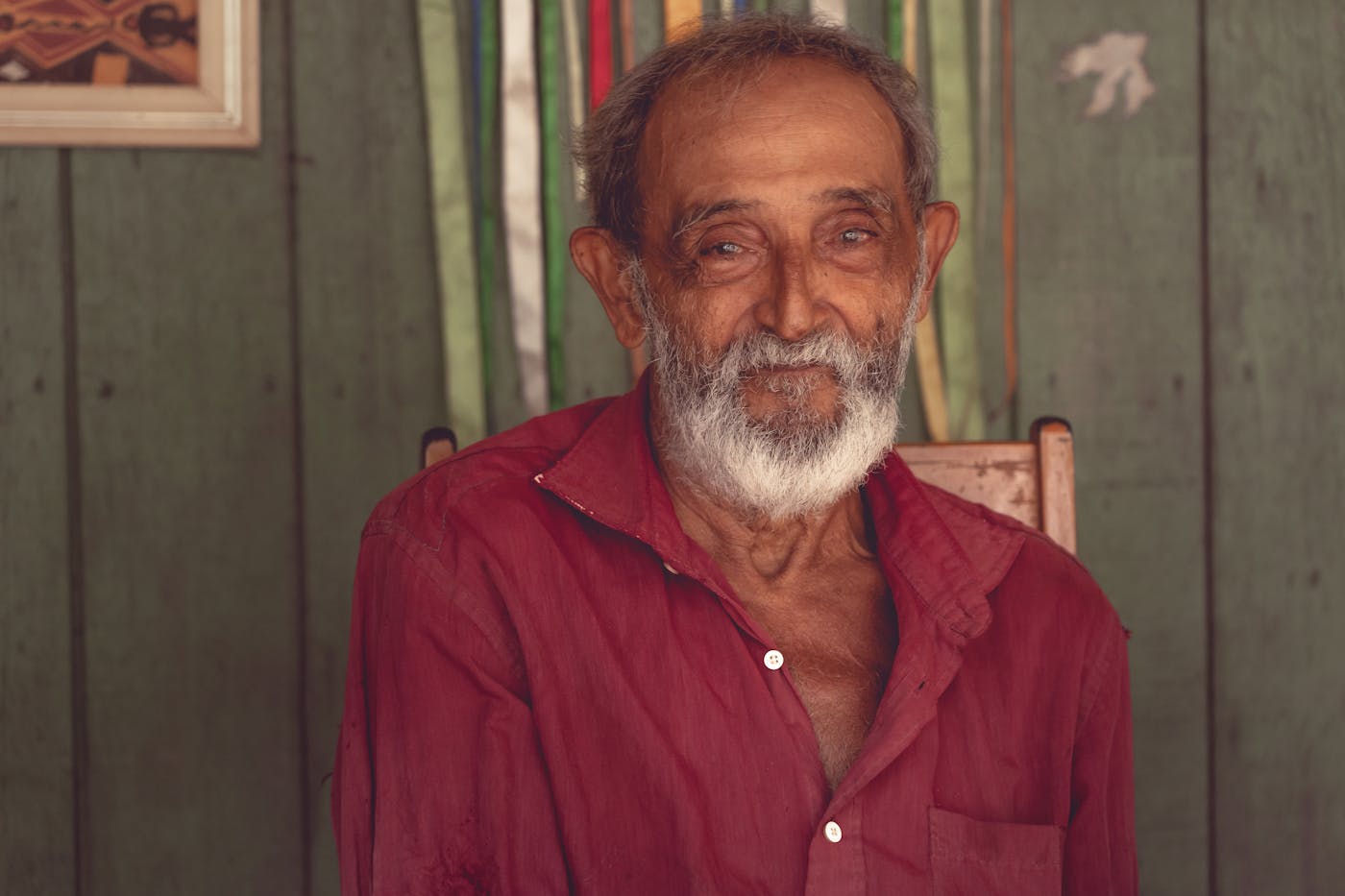
But some families deep in the forest will do whatever it takes to survive without cutting it down, profits or not. Raimundão says that when rubber prices hit rock-bottom in the 1990s, he couldn’t even afford salt. Instead of coffee, the family made tea from native plants. They grew, foraged, or hunted nearly everything they ate. They survived, in other words, from the forest. Even though the Mendeses can now afford to shop in town, they still largely live off the land. As we chat in front of the family home, a relative sits on the porch, sifting the chaff from recently harvested rice. A menagerie of livestock roams the yard, and three little parakeets—free-range pets—peer down with curious eyes from the rafters.
“We want to continue our father’s fight, to take his story forward and defend the forest,” says Rogério, who, unlike many of his peers, has no desire to seek a life off the reserve. “We are happy to live here, but at the same time,” he says, beginning to cry, “we live with the agony that some day we will lose this. It’s a horrible fear, because this is our home.”
This story was produced in collaboration with the Food & Environment Reporting Network, a nonprofit news organization.
